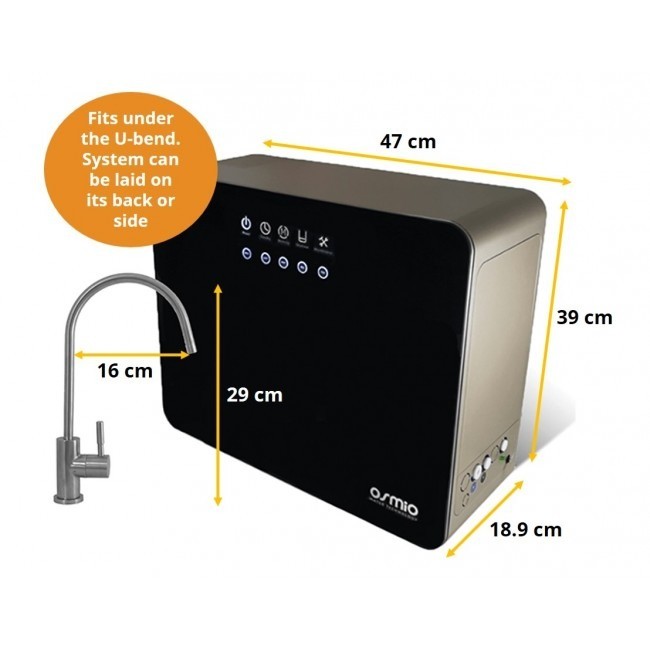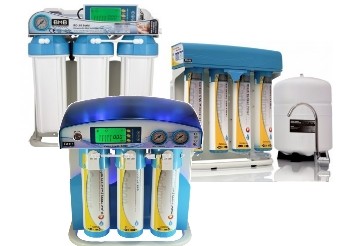What Is A Reverse Osmosis Water Filter?
If you are looking for a water filter you will doubtless have come across the term ‘Reverse Osmosis Water Filter’, sometimes just abbreviated to RO unit or RO system. But what is reverse osmosis filter, how do they work and how do they differ from other water filtration systems?
In normal osmosis, a solvent migrates from an area of low concentration through a semipermeable membrane in to an area of high solute concentration (low water potential). In reverse osmosis pressure is applied to overcome the normal osmotic pressure and reverse the direction of ions, molecules & particulates.
This pressure is ideally achieved by the normal incoming water pipe pressure, however if this is too low then there are reverse osmosis systems available which have built in pumps to ensure constant optimum water pressure.
The Membrane
The heart of any reverse osmosis water filter system is the membrane. The membrane is a spiral wound sheet normally made out of a thin polyamide layer (<200 nm) which is laid on the top of a polyethersulfone or polysulfone porous layer (of approximately 50 microns thickness) which is placed on the top of a non-woven fabric support film. This arrangement known as thin film composite (TFC) allows the filtration of particles down to the molecular level and results in highly purified water.
Whilst a reverse osmosis membrane is quite able to deal with all biological hazards such as viruses and bacteria it is sometimes the case that RO systems are offered with the addition of ultra violet disinfection to ensure the destruction of all biological hazards. This is due not to the ineffectiveness of the RO membrane itself but as a safeguard against leaking seals and film build up in the system. This is a consideration mainly on many of the cheaper models available, care should be taken therefore to select a system which employs only better quality plastics and seals such as the Osmio HT+ Home & Office Direct Flow Reverse Osmosis System and which can supply certification for quality standards.
The capacity of the RO membrane is expressed in GPD or Gallons Per Day as a maximum and typically range between 50 and 100 GPD the actual maximum depending on factors such as water pressure, the age of the membrane, water hardness and temperature.
What Will a Reverse Osmosis Membrane Remove?
The Osmio HT Home & Office Reverse Osmosis Filter Membrane has the following rejection rates:
|
Aluminum |
97-98% |
Nickel |
97-99% |
|
Ammonium |
85-95% |
Nitrate |
93-96% |
|
Arsenic |
94-96% |
Phosphate |
99+% |
|
Bacteria |
99+% |
Polyphosphate |
98-99% |
|
Bicarbonate |
95-96% |
Potassium |
92% |
|
Boron |
50-70% |
Pyrogen |
99+% |
|
Bromide |
93-96% |
Radioactivity |
95-98% |
|
Cadmium |
96-98% |
Radium |
97% |
|
Calcium |
96-98% |
Selenium |
97% |
|
Chloride |
94-95% |
Silica |
85-90% |
|
Chromate |
90-98% |
Silicate |
95-97% |
|
Chromium |
96-98% |
Silver |
95-97% |
|
Copper |
97-99% |
Sodium |
92-98% |
|
Cyanide |
90-95% |
Sulphate |
99+% |
|
Ferrocyanide |
98-99% |
Sulphite |
96-98% |
|
Fluoride |
94-96% |
Zinc |
98-99% |
|
Iron |
98-99% |
||
|
Lead |
96-98% |
Insecticides |
97% |
|
Magnesium |
96-98% |
Detergents |
97% |
|
Manganese |
96-98% |
Herbicides |
97% |
|
Mercury |
96-98% |
Virus |
99+% |
|
TDS (Total Dissolved Solids) |
95-99% |
Hardness |
93-97% |
This is by no means a fully comprehensive list but gives an accurate indication of what percentage of common contaminants can be expected to be removed from the drinking water. These rates may be further enhanced by one or more carbon filters which are normally included in a system.
The System
A typical system will consist of a number of filtration components.
For example the direct flow Osmio D7 consists of
Pre-Filters:
- A 5 Micron Polypropelene Sediment – designed to remove sediments & particulates and protect the filters that follow from clogging.
- A CTO Coconut Shell Carbon
- 1 Micron Polypropelene Sediment
These filters work to protect and extend the life of the membrane and will also reduce or remove Bacteria, E-coli, Chlorine, Sediments, Nitrates, Fluoride, Limescale, Dissolved Solids (TDS), Hormones, Pharmaceuticals, Heavy Metals, all before the water has even reached the RO membrane.
Membrane:
– A 400 GPD Reverse Osmosis Membrane (see above for removal rates). A high capacity RO membrane necessary for a direct flow system
Post filter:
– Alkaline Filter which restores some of the essential & healthy minerals such as calcium & magnesium lost in the reverse osmosis process.
Storage Tank
Depending on the type of system, ie tanked or direct flow, once the purified water has passed through the various filters it then enters the storage tank. The storage tank fills with purified water and once the tap is turned on the pressurised purified water will flow out. Once the demand has ceased, the tank will once again fill up, thus ensuring a continuous supply of filtered water.
Not all RO systems make us of a tank however. There are some models such as the sophisticated Osmio D7 stage reverse osmosis filter which are able to process the water at a fast enough rate (up to 800 GPD) to dispense with the need for a tank. Such models are known as direct flow reverse osmosis systems and achieve this by the use of additional membranes. Apart from the faster production rate they also have the advantage of taking up less space and producing water which has been freshly filtered.
Waste Water
The Water that remains on the concentrated solution side of the membrane is discharged into the drain. This has sometimes led to some concerns about the cost of the waste water.
A typical reject rate would be in the order of 70-80% of the total water processed. Whilst this may appear high it should be bourne in mind that this refers only to the homes drinking water which as a percentage of total household water usage is quite small and in terms of the quality achieved is an acceptable trade off.
A typical Reverse Osmosis unit installation:
Taps
All the reverse osmosis filtration systems supplied by Puriflow Filters include a quality water filter tap which connect to the ¼” or ⅜” pipe coming from the storage tank. These taps, known as single dispenser taps are mounted on the worktop next to the kitchen sink and are used just to dispense the purified RO water. They normally require a ½ “ hole to be drilled through the worktop.
A popular alternative to this arrangement is the use of a three way or triflow water filter tap. These represent an elegant solution where a hole in the worktop is undesirable and replace the normal kitchen tap. Available in a wide range of styles to suit most kitchens they are a convenient and stylish way to dispense filtered drinking water as well as the normal hot and cold supply, from which the filtered water remains separated with its own dedicated channel.
In terms of domestic water treatment methods available, reverse osmosis represents the top end in terms of purity and the degree of choice in filter combinations.
The systems supplied by Puriflow are easy to fit, easy to maintain and will give years of trouble free service, with replacement filters readily available.
If you are unsure what filter is the most suitable for your situation please do contact us on 020 3507 1879 or at info@puriflowfilters.co.uk and we will be happy to discuss the best option for you.







